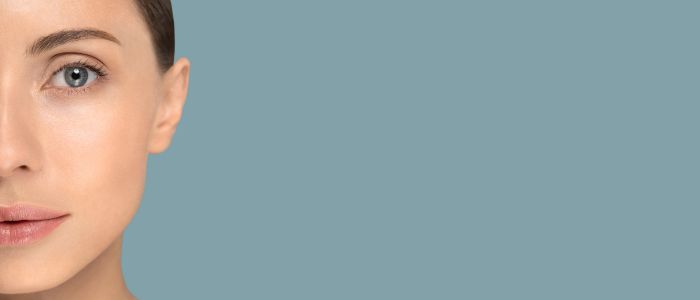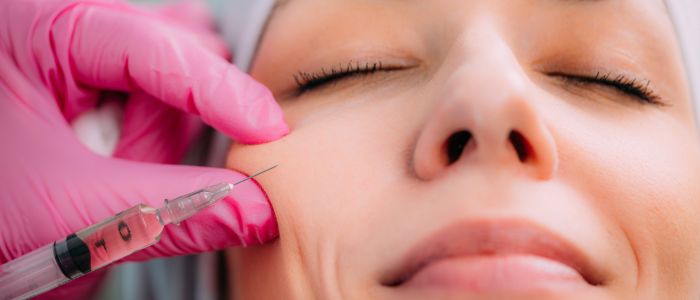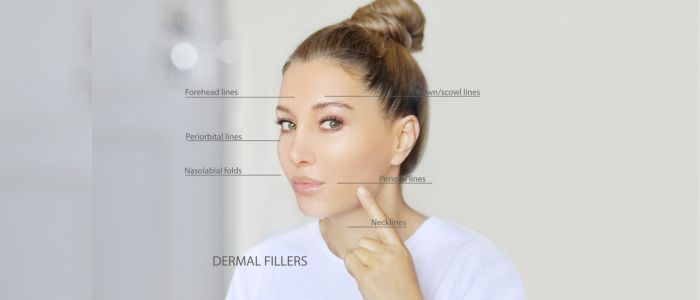
Table of Contents
- Dermal Fillers – A Solution for Facial Volume Loss
- More about Facial Volume Loss
- What are Dermal Fillers?
- Benefits of Dermal Fillers
- Choosing the Right Type of Filler
- Alternative and Complementary Treatments
- Fat Grafting
- Laser Treatments
- Skincare Regimes
- FAQs about Treatments and Solutions for Facial Volume Loss
- Further Reading about Procedures at Cheshire Cosmetic Surgery
Dermal Fillers – A Solution for Facial Volume Loss
Have you noticed changes in your face as you’ve gotten older? Maybe your cheeks aren’t as full as they used to be, or your face doesn’t have that rounded, youthful look anymore. This is often due to something called facial volume loss, which is pretty common as people age. It’s not just about getting older, though. Things like spending a lot of time in the sun, smoking, or not having the best diet can speed this up.
Facial volume loss isn’t just about wrinkles or lines; it’s about losing the plumpness that gives your face a youthful shape. This happens because, over time, you naturally lose some of the fat in your face, and your skin doesn’t bounce back like it used to because it’s not making as much collagen. Collagen is the stuff in your skin that helps keep it firm and smooth. As these changes add up, your face starts to look a bit older than you might feel on the inside.
Many people look for ways to fix this because how we feel about our appearance can really affect our day-to-day life. It can change how you interact with others and even influence your mood. That’s why options like dermal fillers have become so popular. They’re a type of treatment that can help fill in areas where you’ve lost volume, smoothing out the skin and bringing back a more youthful contour to your face.
In this blog, Consultant Plastic Surgeon Anca Breahna will talk about dermal fillers. She will cover what they are, how they work, and why they might be a good option if you’re noticing changes in your face. We’ll look at the different types of fillers, what you can expect when you get them, and how to make sure you find the right person to do the treatment.
More about Facial Volume Loss
Facial volume loss might sound a bit technical, but it’s something quite straightforward. It’s when the face loses some of its underlying fat, which leads to a change in your facial contours and overall appearance. As you get older, this is a normal part of ageing. Your cheeks or areas around your eyes and jawline might look a little hollow or sunken compared to how they once did.
Why does this happen? Well, several factors play a role here:
- Age-related changes: As you age, not only does your skin produce less collagen (the protein that keeps your skin firm), but the structure of your bones can also change. This combination means your skin might sag or loosen because there’s less support from underneath.
- Fat distribution: The way fat is distributed in your face changes too. You might lose fat from some areas, which contributes to that less plump look.
- Skin elasticity: Over time, your skin loses its ability to snap back like it used to. Think of a new elastic band versus an old one that’s been stretched too many times.
But it’s not just about getting older. Your lifestyle can speed up this process:
- Sun exposure: Too much sun can damage your skin and break down the collagen faster than usual.
- Smoking: This habit is tough on your skin. It cuts down on blood flow to your skin’s surface, which can speed up the ageing process.
- Poor diet: Not eating enough foods that are good for your skin, like those rich in vitamins and antioxidants, can also make these changes come on quicker.
What are Dermal Fillers?
If you’re wondering what they actually are, they’re soft, gel-like substances that get injected under your skin. They can help to fill in wrinkles, plump up areas that have lost volume, and even enhance features like your lips or cheeks. People choose dermal fillers for a quick boost in appearance because the results are immediate, and the procedures don’t require much downtime.
There are several types of dermal fillers available, each suited to different needs:
- Hyaluronic acid: This is one of the most common types of fillers. It’s actually a natural substance found in your skin, which helps to keep skin plump and hydrated. Hyaluronic acid fillers can last from six months to over a year before the body gradually absorbs the particles.
- Poly-L-lactic acid: This filler is a biodegradable synthetic substance. It’s known to stimulate your skin’s collagen production. Rather than just filling in space, it works over time to improve skin texture and volume. The effects can last for two years or more.
- Calcium hydroxylapatite: This is another naturally occurring substance, found primarily in our bones. When used as a filler, it’s especially good for deeper lines and wrinkles and can also help stimulate collagen production. The results can last up to a year or more.
So, how do dermal fillers actually work to restore your facial volume? When injected, these fillers plump up the treated area immediately. They can smooth out lines and wrinkles by adding volume under the skin in places where fat has been lost. This process helps to restore a more youthful and refreshed appearance to your face.
Benefits of Dermal Fillers
When it comes to refreshing your look, dermal fillers offer a host of advantages that make them a popular choice for facial rejuvenation. If you’re thinking about whether this treatment could be right for you, here’s a breakdown of the main benefits:
- Immediate Results – One of the most appealing aspects of dermal fillers is the instant improvement you can see once the procedure is done. Unlike some treatments that require time to show results, with dermal fillers, the changes are visible right away. Whether it’s fuller lips, softened wrinkles, or enhanced facial contours, you can walk out of your appointment and see the difference immediately. This makes dermal fillers an excellent option for quick enhancements before big events or special occasions.
- Non-invasive with Minimal Downtime – Dermal fillers are a non-surgical solution and since there’s no surgery involved, the procedure is relatively straightforward and quick, often completed within 30 minutes to an hour depending on the areas treated. After receiving fillers, you can generally return to your daily activities straight away. There might be some slight redness, swelling, or bruising at the injection sites, but these minor side effects usually clear up within a few days. The non-invasive nature of this treatment makes it less daunting than surgical alternatives and a more convenient option for many people.
- Longevity of Results and How It Varies Between Filler Types – The durability of the results from dermal fillers can vary depending on the type of filler used and the area treated. Usually, the effects can last from six months to two years. For example:
- Hyaluronic acid fillers tend to last between six months to one year and are often used for lip enhancement and moderate facial wrinkles.
- Poly-L-lactic acid fillers are designed for longer-lasting results, gradually improving the skin’s texture and volume over time, with effects that can last up to two years.
- Calcium hydroxylapatite also tends to have long-lasting results, usually around 12 to 18 months, and is excellent for deeper lines and facial contouring.
The longevity of these fillers means that you don’t need frequent treatments, making them a time-efficient and cost-effective method for maintaining a youthful appearance.
Choosing the Right Type of Filler
Different fillers work better for different parts of the face because of how they interact with the tissue and how much volume they can provide. Here’s a simple guide:
- Cheeks: To restore volume to the cheeks, a thicker filler like calcium hydroxylapatite or poly-L-lactic acid is often recommended because they provide a more robust structure and can last longer.
- Lips: For lip enhancements, hyaluronic acid fillers are usually the best choice. They are softer and can give your lips a natural-looking fullness and shape.
- Under-eye: The skin under your eyes is very delicate, so a lighter, less dense hyaluronic acid filler works well here. It integrates smoothly and minimises the risk of bumps or irregularities.
Each type of filler has its own set of characteristics and benefits, so it’s important to discuss your options with Anca to determine which one will meet your goals.
Alternative and Complementary Treatments
While dermal fillers are a popular choice for facial rejuvenation, there are several other treatments you might consider either alongside or as alternatives to fillers. Each option has its own set of benefits and can be suited to different needs or preferences.
Fat Grafting
Fat grafting, or fat transfer, is a procedure that involves taking fat from one part of your body, like your thighs or abdomen, and injecting it into areas of your face that have lost volume. This treatment not only fills in wrinkles or sunken areas but also improves skin quality over time, as fat contains stem cells that can help rejuvenate the skin. The results can be very natural-looking and long-lasting since the fat is from your own body. It’s a good option if you’re looking for a more substantial correction that uses natural tissue.
Laser Treatments
Laser treatments can also complement or serve as an alternative to fillers. These procedures use targeted light to treat skin problems on the surface level, such as fine lines, sun damage, or uneven skin tone. Some laser therapies can also stimulate collagen production deep under the skin, which helps improve skin elasticity and firmness over time. While lasers won’t provide the immediate volume that fillers can, they are excellent for overall skin rejuvenation and can enhance the quality and texture of your skin.
Skincare Regimes
Maintaining a solid skincare regime is essential for supporting the health of your skin. Good skincare can complement the effects of procedures like fillers or lasers. For instance, using products with hyaluronic acid can help keep your skin hydrated and plump. Products containing retinoids or vitamin C can stimulate collagen production and protect against damage from the environment. While skincare alone won’t replace the volume lost due to ageing, it can significantly improve skin tone, texture, and resilience.
FAQs about Treatments and Solutions for Facial Volume Loss

What are the risks associated with treatments for facial volume loss?
While treatments like dermal fillers and fat grafting are generally safe, they do carry some risks. Common side effects include swelling, redness, and bruising at the injection site. More serious risks can include allergic reactions, infection, or asymmetry where the filler is not evenly distributed. Choosing a skilled and experienced practitioner is essential to minimise these risks.
How long do I need to wait between treatments if I’m not satisfied with the results?
It’s usually recommended to wait at least two weeks to a month after the initial treatment to allow for any swelling or bruising to subside. This waiting period will enable you to see the final results before deciding if additional treatment is needed.
Can dietary changes help support the results of facial volume treatments?
Yes, incorporating a healthy diet can support your skin’s health and may enhance the results of your treatments. Foods rich in antioxidants, like berries, nuts, and green leafy vegetables, can help protect skin cells from damage. Omega-3 fatty acids, found in fish and flaxseeds, can improve skin’s elasticity. Staying hydrated is also important for maintaining skin hydration and plumpness.
Are there exercises that can help improve facial volume?
Facial exercises, often referred to as “face yoga,” can help improve muscle tone and facial fullness to a degree. Regularly performing exercises that target the cheeks and jawline can help enhance the overall appearance of your face by strengthening facial muscles, potentially boosting the effects of treatments.
What should I consider when choosing between dermal fillers and fat grafting?
When deciding between dermal fillers and fat grafting, consider factors like the longevity of results, the naturalness of the outcome, and recovery time. Dermal fillers offer immediate results and little downtime but typically require repeat treatments to maintain effects. Fat grafting provides a more permanent solution and uses natural body fat, but it involves a more invasive procedure with a longer recovery. Discussing your lifestyle, treatment goals, and tolerance for downtime with Anca can help determine the best option for you.
Medical References about Treatments and Solutions for Facial Volume Loss
- Dermal fillers in aesthetics: an overview of adverse events and treatment approaches – PubMed
- Dermal Fillers: Types, Indications, and Complications – Science Direct
- Injectable Dermal Fillers Guide – American Board of Cosmetic Surgery
- Dermal Fillers: What They Are, Types, Benefits & Side Effects – Cleveland Clinic
- Treatment Options for Dermal Filler Complications – Oxford Academic
Further Reading about Procedures at Cheshire Cosmetic Surgery
- Read more about Recovery after Dermal Fillers
- Read more about Lip Fillers Aftercare
- Read more about Dermal Fillers Removal – How Do They Work?
- Read more about All You Need to Know about Lip Fillers
- Read more about How to Reduce Swelling after Lip Fillers








